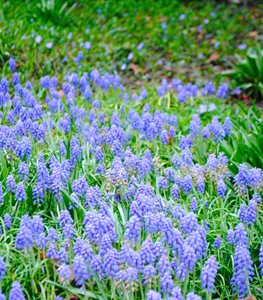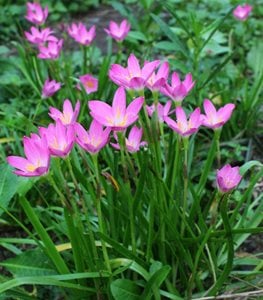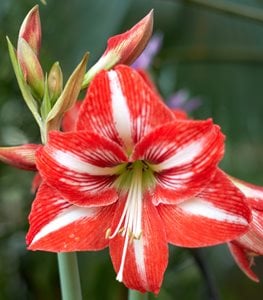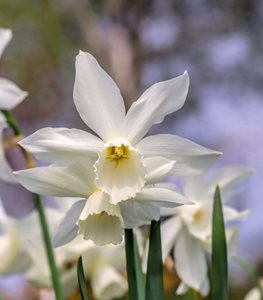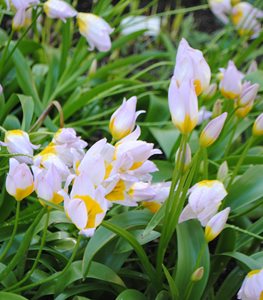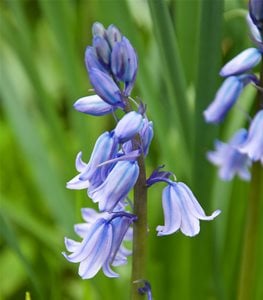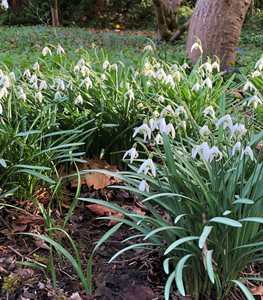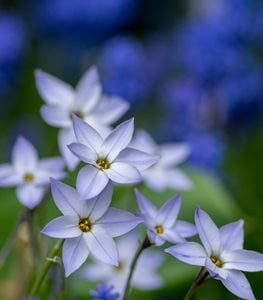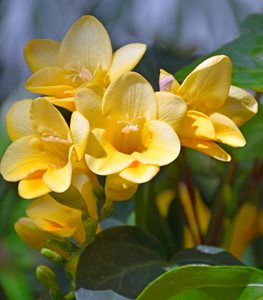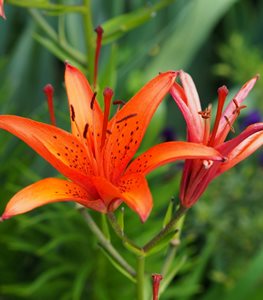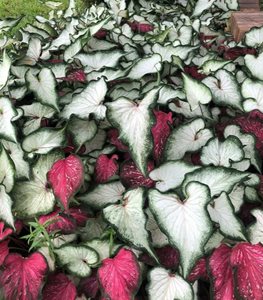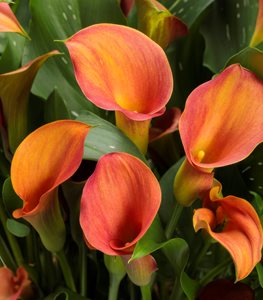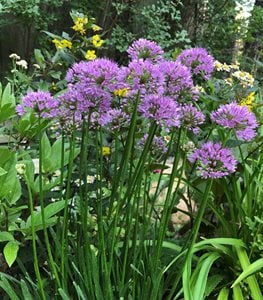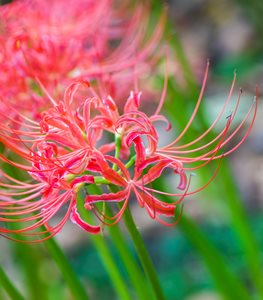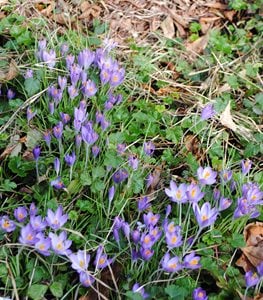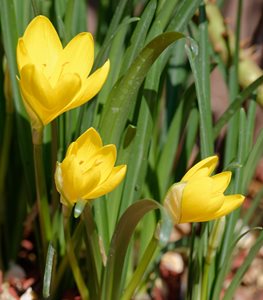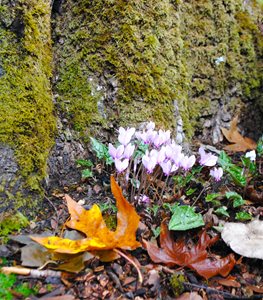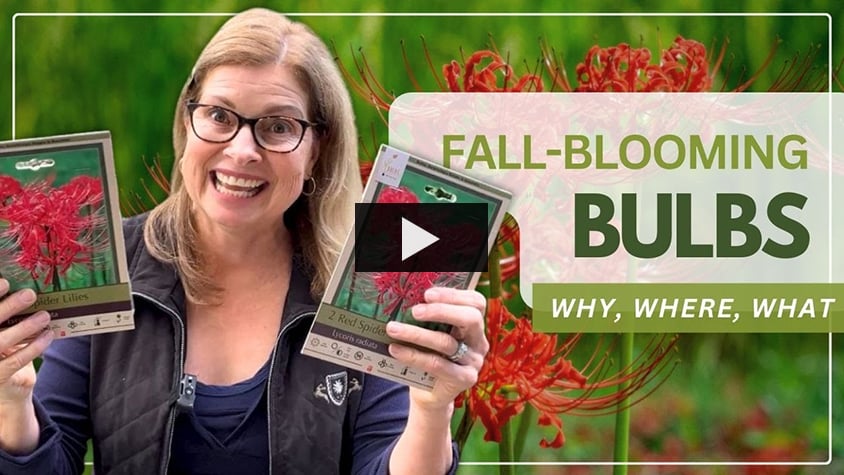Flower Bulbs for Warm Climates
Growing bulbs in warm-climate gardens is possible with these bulb recommendations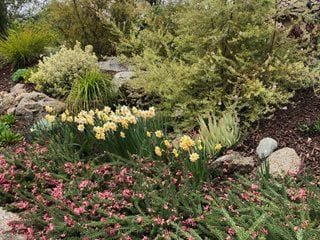
Warm-climate Narcissus ‘Yaz’ and ‘Blushing Lady’ bloom as heartily as any cold-climate varieties. Photo by: Rebecca Sweet.
When talking about growing bulbs, warm-climate gardeners often feel left out of the conversation, assuming there’s very few bulbs that will thrive year after year in mild winters. In garden magazines, images of colorful tulips in a rainbow of colors or giant orbs of purple allium that bob and float throughout the garden bed make the gentlest gardener turn green with envy.
Many bulbs require a period of winter chill in order to flower, which is lacking in warm climates (Zones 9 and up), where temperatures rarely dip below 30 degrees. Many tulips and daffodils, for example, require at least eight to twelve consecutive weeks of consistently cold temperatures to force the bulbs into dormancy until spring’s warmer temps signal that it’s time to bloom.
Luckily, however, more and more providers are offering an array of bulbs that thrive and bloom in warm-climate gardens. Here are a few suggestions for bulbs that do well in warmer-climate gardens.
On this page: Late Winter | Spring | Summer | Fall
On this page:
LATE WINTER
GRAPE HYACINTH (Muscari spp.)
Zones: 4-9
Exposure: Full sun to partial shade
Bloom time: Late winter to early spring
Height/Spread: 6 to 9 inches tall, 2 to 6 inches wide, upright spreading habit
Uses: Naturalize in garden beds and borders, woodland settings, rock gardens, containers, force indoors for winter blooms.
With flowers resembling clusters of grapes, aptly named grape hyacinths are some of the easiest warm-climate bulbs to grow in the garden. The diminutive flowers come in colors ranging from dark purple to pink and white. Muscari will quickly multiply (can become invasive in some areas) to form an impressive drift of color. A few favorites are ‘Peppermint’ with its pale blue flowers and foliage that tends to be more upright than other varieties, and the sapphire-blue blooms of ‘Dark Eyes’ that are lightly tipped with white. May be grown in containers to control spread.
Learn more about growing grape hyacinth.
RAIN LILY (Zephranthes spp.)
Zones: 7-10
Exposure: Full sun to partial shade
Bloom time: Early winter and again in early spring
Height/Spread: 6 to 12 inches tall and wide; upright clumping habit
Uses: Naturalize in a woodland setting; front of the border, rock gardens, containers.
An unusual bulb with evergreen grass-like foliage throughout the year, bursting forth with a profusion of crocus-like flowers with the first fall rain. Zephranthes alba has crisp, white flowers, Zephranthes citrina has golden-yellow blooms, and Zephranthes grandiflora has slightly larger pink blooms. Their low-growing habit makes them ideal for the front of the border.
AMARYLLIS (Hippeastrum spp.)
Zones: 8-10
Exposure: Partial shade
Bloom time: Late winter to early spring
Height/Spread: 12 to 36 inches tall; upright habit
Uses: Mixed borders, cottage gardens, containers, forcing indoors for winter blooms.
Tender and tropical amaryllis bulbs are easy to grow in warm climates. Dwarf amaryllis are often more prolific than other varieties, with a longer show of flowers in the garden. Varieties such as ‘Baby Star’ (pictured) or ‘Fairy Tale’ will produce a larger quantity of smaller flowers per stem, with several stems per bulb. ‘Neon’ amaryllis, growing to 16 inches, has fuchsia-pink blooms with subtle white striations sure to light up the semi-dormant garden.
Learn more about growing amaryllis.
SPRING
DAFFODILS AND PAPERWHITES (Narcissus spp.)
Zones: 3-9
Exposure: Full sun to partial shade
Bloom time: Late winter to spring
Height/Spread: 12 to 24 inches tall, 6 to 8 inches wide
Uses: Mixed borders, naturalistic garden setting, containers, or rock or gravel gardens.
There are hundreds of varieties available in just about any color imaginable; but keep in mind that most Narcissus require extended winter chill for repeat blooms. There are, however, several varieties that reliably return in warm climates, with personal favorites being 'Thalia' (pictured), 'Avalanche’, 'Bantam’, 'Elka’, 'Yaz’, 'Regeneration’, 'White Petticoat’, and 'Golden Bells.’
Learn more about growing daffodils and paperwhites.
SPECIES TULIPS (Tulipa spp.)
Zones: 3-10
Exposure: Full sun to partial shade
Bloom time: Early to mid-spring
Height/Spread: 6 to 14 inches tall, 4 to 6 inches wide; upright habit
Uses: Naturalistic garden, front of the border, containers, rock and gravel gardens.
Species tulips are smaller than the more common hybrid tulips but are just as colorful. They also have a longer bloom time and easily naturalize, forming colorful drifts. Their smaller size makes them an ideal choice to grow in the front of the border. Personal favorites include T. bakeri 'Lilac Wonder’ (pictured), T. urumiensis, T. clusiana 'Tubergen's Gem’, 'Cynthia’, and 'Peppermint Stick.’
Learn more about growing tulips.
SPANISH BLUEBELLS (Hyacinthoides hispanica)
Zones: 3-9
Exposure: Full sun to partial shade
Bloom time: Mid-spring
Height/Spread: 8 to 20 inches tall and wide; upright spreading habit
Uses: Naturalize in woodland settings, forms drifts under deciduous trees and shrubs.
A few bulbs of Spanish bluebells will quickly colonize to form a drift of clear blue, bell-shaped flowers held high on strong stems, surrounded by strappy green foliage. While blue is the most common color, they can also be found in colors ranging from white to light pink. NOTE:They may be considered invasive in some areas.
SUMMER SNOWFLAKE (Leucojum aestivum)
Zones: 4-9
Exposure: Sun to partial shade
Bloom time: Generally blooms mid to late spring, but may bloom earlier in warmer climates
Height/Spread: 20 inches tall
Uses: Naturalize in a woodland setting, rock gardens, under deciduous trees and shrubs
Leucojum aestivum is commonly called summer snowflake, even though they bloom in spring. Their blooms resemble snowdrops (Galanthus); however, the plants are taller and bloom later, typically after daffodils. While snowdrops are a common sight in cold-climate gardens, summer snowflakes thrive in warmer temperatures, with ‘Gravetye Giant’ being a favorite. Its sturdier stems help keep it upright in strong winds while having larger flowers than other varieties. Not to be confused with spring snowflake, Leucojum vernum, which blooms earlier.
STARFLOWER (Ipheion uniflorum)
Zones: 5-9
Exposure: Full sun to partial shade
Bloom time: Mid to late spring
Height/Spread: 3 to 6 inches tall and wide; upright habit
Uses: Front of the border, along pathways, underplanting roses and shrubs, containers, rock and gravel gardens, naturalized within lawns.
The star-shaped blooms of the spring starflower might look delicate, but don’t let that fool you; this bulb is tough as nails. Cool-toned flowers in shades of white and lavender complement the warmer tones of many daffodils and freesia, and their small stature makes them ideal for layering under taller bulbs and perennials. The award-winning ‘Wisley Blue’ (pictured) has lilac-blue blooms with a darker blue stripe on each petal.
FREESIA (Freesia spp.)
Zones: 9-10
Exposure: Full sun to partial shade
Bloom time: Spring and summer
Height/Spread: 12 to 24 inches tall, spreading 6 to 24 inches wide; upright habit
Uses: Front of the border, containers, cutting garden, cottage garden, moon gardens, good for creating drifts.
Sweetly-scented freesia flowers are a favorite among gardeners and are available in a wide range of colors. The tubular flowers are held on long, slender stems and are a magnet for bees and other pollinators. Their fragrance is strongest in the early evening, making them a good candidate for moon gardens.
Learn more about growing freesias.
SUMMER
ORANGE LILY (Lilium bulbiferum)
Zones: 3-9
Exposure: Full sun to partial shade
Bloom time: Early summer
Height/Spread: 3 to 4 feet tall, 2 to 3 feet wide; upright habit
Uses: Middle of the border, traditional or cottage gardens, containers.
A group of blooming orange lilies will wake the early summer garden with a mass of prolific, brilliant, deep orange flowers. Easy to grow and reliably returns year after year, with upward-facing flowers that attract a variety of pollinators.
Learn more about growing lilies.
CALADIUM (Caladium spp.)
Zones: 9-11
Exposure: Partial to full shade
Bloom time: Flowers are insignificant
Height/Spread: 12 to 24 inches tall, 8 to 24 inches wide; upright spreading habit.
Uses: Shade gardens, cottage gardens, containers, window boxes.
Tropical-looking caladiums are a show-stopper in the shady garden, with oversized heart-shaped foliage up to 20” long and available in a dizzying array of color combinations. Their upright form makes them ideal for layering with low-growing plants, such as impatiens, small ferns, or heucheras.
Learn more about growing caladiums.
CALLA LILIES (Zantedeschia aethiopica)
Zones: 7-10
Exposure: Full sun to partial shade
Bloom time: Early to late summer
Height/Spread: 2 to 3 feet tall, 2 to 3 feet wide; upright habit.
Uses: Middle of the border, cottage garden, containers, ponds and streams.
Depending on the variety, calla lilies bloom in spring, summer, or fall in colors ranging from pure white to vivid yellow, plum, and orange. The elegant, upright, trumpet-shaped blooms are a focal point when planted in the middle or back of the border and make excellent cut flowers. With seasonally selected varieties, it’s easy to have blooms for months at a time.
Learn more about growing calla lilies.
ORNAMENTAL ONION (Allium)
'Millenium' or 'Lavender Bubbles'
Zones: 4-10 Exposure: Full sunBloom time: Spring and summer
Height/Spread: 8 to 12 inches tall, 10 to 20 inches wide; upright habit.
Uses: Plant in borders, cottage gardens, rock or gravel gardens, containers, cut flower gardens.
The colorful, spherical heads of ornamental onions are a common sight in garden magazines. However, only a few varieties thrive in warmer climates. ‘Millenium’ (pictured) and ‘Lavender Bubbles’ have the same globe-shaped flower heads but are smaller in size and in shades of lavender and light purple. While they may be subtler than their show-stopping, cold-climate cousins, they more than make up for this fact with their heat tolerance and prolific blooms, reliably returning year after year.
Learn more about growing alliums.
FALL
RED SPIDER LILY (Lycoris radiata)
Zones: 6-10
Exposure: Full sun to partial shade
Bloom time: Late summer to early fall
Height/Spread: 1 to 2 feet tall and wide; upright habit
Uses: Informal and cottage gardens, front of the border, containers.
The vibrant red blooms of the spider lily make this a welcome addition to the fall garden. Tall, slender stems slowly emerge from the ground, topped with umbel-shaped flowers of coral-red flowers with curled petals. The strappy dark green foliage appears once the flowers begin to fade, lasting through winter until summer’s heat causes the bulb to go dormant, once again. Consider combining a few Lycoris bulbs with golden Colchinium bulbs for an eye-catching fall display.
AUTUMN CROCUS (Colchicum autumnale)
Zones: 4-9
Exposure: Full sun
Bloom time: Fall
Height/Spread: 6 to 12 inches tall, 2 to 3 inches wide; upright habit
Uses: Informal and cottage gardens, front of the border, meadow planting, containers, underplanting roses and shrubs.
This summer-dormant bulb is indispensable for the fall garden, adding a pop of color when other plants are winding down. Though small in height, the cup-shaped flowers are 2 to 3 inches and bloom in vibrant colors ranging from golden yellow to pink, purple, or white. When allowed to naturalize, they’ll form an impressive autumn display.
YELLOW AUTUMN CROCUS (Stenbergia lutea)
Zones: 6-9
Exposure: Full sun
Bloom time: Fall
Height/Spread: 3 to 6 inches tall and wide; upright habit
Uses: Front of the border, rock and gravel gardens, cottage gardens, underplanting roses and shrubs.
Similar to an oversized crocus, this fall-flowering bulb is easy to grow and will naturalize into a colorful drift in just a few years. The goblet-shaped 1 ½-inch flowers are a cheery yellow with grass-like foliage that lasts through winter. Once summer arrives, the bulb goes dormant until the cooler temperatures of fall arrive once again.
IVY-LEAVED CYCLAMEN (Cyclamen hederifolium)
Zones: 4-9
Exposure: Partial to full shade
Bloom time: Fall to early spring
Height/Spread: 2 to 6 inches tall, 4 to 12 inches wide; upright mounding or spreading habit
Uses: Naturalize in a woodland setting, rock gardens, containers, good for the front of the border.
Once summer’s heat begins to subside, slender stalks emerge, topped with delicate pink flowers. These naked blooms herald the beginning of fall. As the flowers begin to fade, the exquisitely patterned ivy-shaped foliage appears. The eye-catching mound of foliage remains until the return of summer’s heat when the plant once again becomes dormant.
Learn more about growing lilies.
Create Magic in Your Garden with Fall Blooming Bulbs
Transform your fall garden with the guidance of gardening expert Rebecca Sweet from Harmony in the Garden. Discover how she uses fall-blooming bulbs to create three dynamic combinations full of visual energy.
RELATED:
7 Tips for a Beautiful Bulb Garden
Spring-Blooming Bulbs
Summer-Blooming Bulbs
How & When to Plant Bulbs
